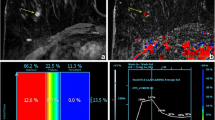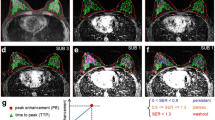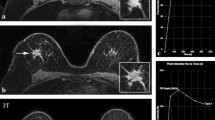Abstract
Objective
To analyse the kinetic characteristics of lesions without mass effect in dynamic breast MRI using manual and computer assisted methods.
Methods
The enhancement pattern of 82 histopathologically verified lesions without mass effect (36 malignant, 46 benign) was evaluated on breast MRI using manual placement of a region of interest. Commercially available computer analysis software automatically assessed volume enhancement characteristics of a lesion voxelwise. Kinetic features evaluated included classification of the signal-intensity time curve as washout, plateau or persistent enhancement.
Results
Unlike manual ROI placement, computer-aided analysis demonstrated a significant difference in enhancement pattern between benign (washout: 32.6%, plateau: 32.6%, persistent: 34.8%) and malignant lesions without mass effect (77.1%, 8.6%, 14.3% respectively, P < 0.01, two-sided Chi-squared test) following initial rapid signal increase. Mean percentage of washout voxel volumes within a lesion was significantly higher in malignant lesions than in benign lesions (11.9% +/−12.7 (SD) vs. 6.9% +/−11.3 (SD), P < 0.01, Mann–Whitney U Test). Conversely, the mean percentage of persistent voxel volumes was significantly lower in malignant lesions than in benign lesions (60.1% +/−21.1 (SD) vs. 79% +/−23 (SD), P < 0.01, Mann–Whitney U Test).
Conclusion
Computer-assisted enhancement pattern analysis might have diagnostic benefit in the evaluation of lesions without mass effect.


Similar content being viewed by others
References
Drew PJ, Chatterjee S, Turnbull LW et al (1999) Dynamic contrast enhanced magnetic resonance imaging of the breast is superior to triple assessment for the pre-operative detection of multifocal breast cancer. Ann Surg Oncol 6:599–603
Kristoffersen Wiberg M, Aspelin P, Perbeck L et al (2002) Value of MR imaging in clinical evaluation of breast lesions. Acta Radiol 43:275–281
Stomper PC, Herman S, Klippenstein DL et al (1995) Suspect breast lesions: findings at dynamic gadolinium-enhanced MR imaging correlated with mammographic and pathologic features. Radiology 197:387–395
Boné B, Aspelin P, Bronge L et al (1996) Sensitivity and specificity of MR mammography with histopathological correlation in 250 breasts. Acta Radiol 37:208–213
Ikeda DM, Hylton NM, Kinkel K et al (2001) Development, standardization and testing of a lexicon for reporting contrast enhanced breast magnetic resonance imaging studies. J Magn Reson Imaging 13:889–895
Malich A, Fischer DR, Wurdinger S et al (2005) Potential MRI interpretation model: differentiation of benign from malignant breast masses. Am J Roentgenol 185:964–970
Fischer DR, Wurdinger S, Boettcher J et al (2005) Further signs in the evaluation of magnetic resonance mammography: a retrospective study. Invest Radiol 40:430–435
Kaiser WA (2007) Breast magnetic resonance imaging: principles and techniques. Semin Roentgenol 42:228–235
Berg WA, Gutierrez L, NessAiver MS et al (2004) Diagnostic accuracy of mammography, clinical examination, US, and MR imaging in preoperative assessment of breast cancer. Radiology 233:830–849
Kuhl CK, Mielcareck P, Klaschik S et al (1999) Dynamic breast MR imaging: are signal intensity time course data useful for differential diagnosis of enhancing lesions? Radiology 211:101–110
Baltzer PA, Benndorf M, Dietzel M et al (2010) False positive findings at contrast enhanced breast MRI. A BI-RADS descriptor study. Am J Roentgenol 194:1658–1663
Guitterrez ML, DeMartini WB, Eby PR et al (2009) BI-RADS lesions characteristics predict likelihood of malignancy in breast MRI for masses but not for non-mass enhancement. Am J Roentgenol 193:994–1000
Baltzer PA, Freiberg C, Beger S et al (2009) Clinical MR-mammography: are computer assisted methods superior to visual or manual measurements for curve type analysis? A systemic approach. Acad Radiol 16:1070–1076
Kaiser WA, Zeitler E (1989) MR imaging of the breast: fast imaging sequences with and without Gd-DTPA: Preliminary observations. Radiology 170:681–686
Bluemke DA, Gatsonis CA, Chen MH et al (2004) Magnetic resonance imaging of the breast prior to biopsy. JAMA 292:2735–2742
Jansen S, Fan X, Karczmar G et al (2008) DCEMRI of breast lesions: Is kinetic analysis equally effective for both mass and non-mass like enhancement? Med Phys 37:3102–3110
Neubauer H, Li M, Kuehne-Heid R et al (2003) High grade and non-high grade ductal carcinoma in situ on dynamic MR mammography: characteristic findings for signal increase and morphological pattern of enhancement. Br J Radiol 76:3–12
Jansen SA, Newstead GM, Abe H et al (2007) Pure ductal carcinoma in situ: kinetic and morphologic MR characteristics compared with mammographic appearance and nuclear grade. Radiology 245:684–691
Guidi AJ, Fischer L, Harris JR et al (1994) Microvessel density and distribution in ductal carcinoma in situ of the breast. J Natl Cancer Inst 86:614–619
Gilles R, Zafrani B, Guinebretière JM et al (1995) Ductal carcinoma in situ: MR imaging-histopathologic correlation. Radiology 196:415–419
Pabst T, Kenn W, Kaiser WA et al (2001) Understanding why contrast enhancement in dynamic MRI is not reproducible: illustration with a simple phantom. Breast J 7:166–170
Yabuuchi H, Matsuo Y, Kamitaki T et al (2010) Non-mass like enhancement on contrast enhanced breast imaging: lesion characterization using a combination of dynamic contrast enhanced and diffusion weighted MR images. Eur J Radiol 75:126–132
Author information
Authors and Affiliations
Corresponding author
Rights and permissions
About this article
Cite this article
Vag, T., Baltzer, P.A.T., Dietzel, M. et al. Kinetic analysis of lesions without mass effect on breast MRI using manual and computer-assisted methods. Eur Radiol 21, 893–898 (2011). https://doi.org/10.1007/s00330-010-2001-6
Received:
Revised:
Accepted:
Published:
Issue Date:
DOI: https://doi.org/10.1007/s00330-010-2001-6




